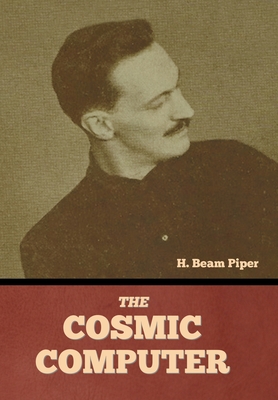The Cosmic Computer

The Cosmic Computer
A solid sci-fi yarn about a backwater planet with access to huge stores of salvageable war surplus teetering on the edge of economic collapse and their search for a long forgotten super computer that they hope can help turn their fate around. About the authorHenry Beam Piper (March 23, 1904 - c. November 6, 1964) was an American science fiction writer. He wrote many short stories and several novels. He is best known for his extensive Terro-Human Future History series of stories and a shorter series of "Paratime" alternate history tales. He wrote under the name H. Beam Piper. Another source gives his name as "Horace Beam Piper" and a different date of death. His gravestone says "Henry Beam Piper". Piper himself may have been the source of part of the confusion; he told people the H stood for Horace, encouraging the assumption that he used the initial because he disliked his name. On a copy of Little Fuzzy given to Charles O. Piper, Beam's cousin and executor, he wrote "To Charles from Henry." Piper was largely self-educated; he obtained his knowledge of science and history "without subjecting myself to the ridiculous misery of four years in the uncomfortable confines of a raccoon coat." He went to work at age 18 as a laborer at the Pennsylvania Railroad's Altoona yards in Altoona, Pennsylvania. He also worked as a night watchman for the railroad. Piper published his first short story, "Time and Time Again", in 1947 in Astounding Science Fiction; it was adapted for the radio program Dimension X and first broadcast in 1951, and was re-produced for X Minus One in 1956. He was primarily a short story author until 1961, when he made a productive, if short-lived, foray into novels. He collected guns and wrote one mystery, Murder in the Gunroom. In 1964, his career apparently on the skids, and prevented by reticence and his libertarian principles from asking anyone to assist him with his financial difficulties, Piper committed suicide. The exact date of his death is unknown; the last entry in his diary was dated November 5 ("Rain 0930"), and according to his Pennsylvania death certificate his body was found on November 8. According to Jerry Pournelle's introduction to Little Fuzzy, Piper shut off all the utilities to his apartment, put painter's drop-cloths over the walls and floor, and took his own life with a handgun from his collection. In his suicide note, he gave an explanation that "I don't like to leave messes when I go away, but if I could have cleaned
PRP: 235.11 Lei
Acesta este Pretul Recomandat de Producator. Pretul de vanzare al produsului este afisat mai jos.
211.60Lei
211.60Lei
235.11 LeiLivrare in 2-4 saptamani
Descrierea produsului
A solid sci-fi yarn about a backwater planet with access to huge stores of salvageable war surplus teetering on the edge of economic collapse and their search for a long forgotten super computer that they hope can help turn their fate around. About the authorHenry Beam Piper (March 23, 1904 - c. November 6, 1964) was an American science fiction writer. He wrote many short stories and several novels. He is best known for his extensive Terro-Human Future History series of stories and a shorter series of "Paratime" alternate history tales. He wrote under the name H. Beam Piper. Another source gives his name as "Horace Beam Piper" and a different date of death. His gravestone says "Henry Beam Piper". Piper himself may have been the source of part of the confusion; he told people the H stood for Horace, encouraging the assumption that he used the initial because he disliked his name. On a copy of Little Fuzzy given to Charles O. Piper, Beam's cousin and executor, he wrote "To Charles from Henry." Piper was largely self-educated; he obtained his knowledge of science and history "without subjecting myself to the ridiculous misery of four years in the uncomfortable confines of a raccoon coat." He went to work at age 18 as a laborer at the Pennsylvania Railroad's Altoona yards in Altoona, Pennsylvania. He also worked as a night watchman for the railroad. Piper published his first short story, "Time and Time Again", in 1947 in Astounding Science Fiction; it was adapted for the radio program Dimension X and first broadcast in 1951, and was re-produced for X Minus One in 1956. He was primarily a short story author until 1961, when he made a productive, if short-lived, foray into novels. He collected guns and wrote one mystery, Murder in the Gunroom. In 1964, his career apparently on the skids, and prevented by reticence and his libertarian principles from asking anyone to assist him with his financial difficulties, Piper committed suicide. The exact date of his death is unknown; the last entry in his diary was dated November 5 ("Rain 0930"), and according to his Pennsylvania death certificate his body was found on November 8. According to Jerry Pournelle's introduction to Little Fuzzy, Piper shut off all the utilities to his apartment, put painter's drop-cloths over the walls and floor, and took his own life with a handgun from his collection. In his suicide note, he gave an explanation that "I don't like to leave messes when I go away, but if I could have cleaned
Detaliile produsului









